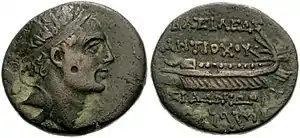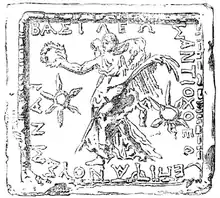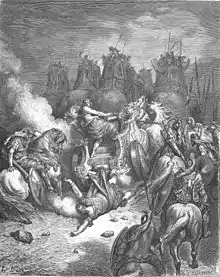| Antiochus IV Epiphanes | |
|---|---|
 Bust of Antiochus IV at the Altes Museum in Berlin. | |
| Basileus of the Seleucid Empire | |
| Reign | 3 September 175 – November/December 164 BC |
| Predecessor | Antiochus, son of Seleucus IV |
| Successor | Antiochus V Eupator |
| Born | c. 215 BC |
| Died | November/December 164 BC (aged 50–51) |
| Wife | |
| Issue |
|
| Dynasty | Seleucid |
| Father | Antiochus III the Great |
| Mother | Laodice III |
| Religion | Greek polytheism |
Antiochus IV Epiphanes[note 1] (c. 215 BC – November/December 164 BC)[1] was a Greek Hellenistic king who ruled the Seleucid Empire from 175 BC until his death in 164 BC. He was a son of King Antiochus III the Great. Originally named Mithradates (alternative form Mithridates), he assumed the name Antiochus after he ascended the throne.[2] Notable events during Antiochus's reign include his near-conquest of Ptolemaic Egypt, his persecution of the Jews of Judea and Samaria, and the rebellion of the Jewish Maccabees.
Antiochus's accession to the throne was controversial, and he was seen as a usurper by some. After the death of his brother Seleucus IV Philopator in 175 BC, the "true" heir should have been Seleucus's son Demetrius I. However, Demetrius I was very young and a hostage in Rome at the time, and Antiochus seized the opportunity to declare himself king instead, successfully rallying enough of the Greek ruling class in Antioch to support his claim. This helped set a destabilizing trend in the Seleucid Empire in subsequent generations, as an increasing number of claimants tried to usurp the throne. After his own death, power struggles between competing lines of the ruling dynasty heavily contributed to the collapse of the empire.
Antiochus' often eccentric behaviour and capricious actions during his interactions with common people, such as appearing in the public bathhouses and applying for municipal offices, led some of his contemporaries to call him Epimanes (Ἐπιμανής, Epimanḗs, "The Mad"), a wordplay on his title Epiphanes.
Biography
Rise to power
Antiochus, born around 215 BC, was a son of the Seleucid king Antiochus III the Great.[3][4] As a potential successor to the throne, he became a political hostage of the Roman Republic under the terms of the Treaty of Apamea, concluded in 188 BC. After his older brother Seleucus IV Philopator succeeded their father onto the throne in 187 BC, Antiochus was exchanged for his nephew Demetrius, the son and heir of Seleucus. After this Antiochus lived in Athens, and was there when his brother was assassinated in 175 BC by the government minister Heliodorus.
Heliodorus proclaimed himself regent afterward, essentially giving himself control of the government. This arrangement did not last long. With the help of king Eumenes II of Pergamum, Antiochus IV traveled from Athens through Asia Minor and reached Syria by November 175 BC. Seleucus' legitimate heir Demetrius was still a hostage in Rome, so Antiochus seized the throne for himself, proclaiming himself co-regent with another son of Seleucus, an infant named Antiochus. (Antiochus, son of Seleucus IV would later die in 170 BC, possibly murdered by Antiochus IV).[5][6]
Ruling style
Antiochus IV cultivated a reputation as an extravagant and generous ruler. He scattered money to common people in the streets of Antioch; gave unexpected gifts to people he did not know; contributed money to the Temple of Zeus at Athens and the altar at Delos; put all his Western military forces on a massive parade at Daphne, a suburb of Antioch; and held opulent banquets with the aristocracy using the best spices, clothing, and food.[7] He also supplemented the Seleucid army with mercenaries. All of this cost the Seleucid treasury, but the Empire was apparently able to raise enough taxes to pay for it. His eccentric behavior and unexpected interactions with common people such as appearing in the public bath houses and applying for municipal offices led his detractors to call him Epimanes (Ἐπιμανής, Epimanḗs, "The Mad"), a word play on his title Epiphanes ("God Manifest").[8][7]
Wars against Egypt and relations with Rome

After his ascension Antiochus took care to maintain good relations with the Roman Republic, sending an embassy to Rome in 173 BC with a part of the unpaid indemnity still owed from the 188 BC Treaty of Apamea. While there the embassy secured a renewed treaty of friendship and alliance with Rome, greatly helped by the fact Antiochus had come to power with the help of Eumenes II, Rome's principal ally in the region.
The guardians of King Ptolemy VI Philometor demanded the return of Coele-Syria in 170 BC, declaring war on the Seleucids on the assumption that the kingdom was divided after Antiochus' murder of his nephew. However Antiochus had warning of the attack and had prepared more thoroughly. He had already built his forces and moved them into position; as soon as the Egyptian forces left Pelusium they were attacked and defeated by Antiochus IV and his Seleucid army. The Seleucids then seized Pelusium, giving them supplies and access to all of Egypt. He advanced into Egypt proper, conquering all but Alexandria and capturing King Ptolemy. This was partially achieved because Rome (Ptolemaic Egypt's traditional ally) was embroiled in the Third Macedonian War and was not willing to become involved elsewhere.[9]
To avoid alarming Rome, Antiochus allowed Ptolemy VI to continue ruling as a puppet king from Memphis. Upon Antiochus' withdrawal, the city of Alexandria chose a new king, one of Ptolemy's brothers, also named Ptolemy (VIII Euergetes). The Ptolemy brothers reconciled and agreed to rule Egypt jointly instead of fighting a civil war.[10]
In 168 BC, Antiochus led a second attack on Egypt and also sent a fleet to capture Cyprus. Before he reached Alexandria, his path was blocked by a single elderly Roman ambassador named Gaius Popillius Laenas who delivered a message from the Roman Senate directing Antiochus to withdraw his armies from Egypt and Cyprus or consider himself in a state of war with the Roman Republic. Antiochus said he would discuss it with his council, whereupon the Roman envoy drew a line in the sand around Antiochus and said: "Before you leave this circle, give me a reply that I can take back to the Roman Senate." This implied Rome would declare war if the King stepped out of the circle without committing to leave Egypt immediately. Weighing his options, Antiochus decided to withdraw. Only then did Popillius agree to shake hands with him.[11] Ancient sources and traditional historiography describe this "Day of Elesius" as a great humiliation for Antiochus IV that unhinged him for a time. Some more modern historians conjecture that Antiochus may have been more reconciled to this than ancient sources indicate, as the Roman intervention meant that Antiochus had been given an excuse to not undertake a potentially long and costly siege of Alexandria. He could instead return with treasure and loot having weakened the Egyptian state at little risk and cost compared to a larger-scale invasion.[10][12]
Persecution of the Jews and the Maccabean revolt

The Seleucids, like the Ptolemies before them, held a suzerainty over Judea: they respected Jewish culture and protected Jewish institutions. This policy was drastically reversed by Antiochus IV, seemingly after what was either a dispute over leadership of the Temple in Jerusalem and the office of High Priest, or possibly a revolt whose nature was lost to time after being crushed.

Local revolts against the Seleucid Empire were not unusual, but most were not successful. The revolt that Antiochus IV ultimately triggered in Judea was unusually well chronicled and preserved, however. According to the book of 2 Maccabees, the crisis had its origins in the years leading up to the Sixth Syrian War. In 171 BC, Antiochus had deposed the High Priest Jason and replaced him with Menelaus, who had offered Antiochus a large bribe to secure the office. In 168 BC, when Antiochus was campaigning in Egypt, a rumor spread in Judea that he had been killed. Jason gathered a force of 1,000 soldiers and made a surprise attack on the city of Jerusalem. Menelaus was forced to flee Jerusalem during the ensuing riot.[13] Jason's intention may have been to retake his former office by force and present his reassumption of power as fait accompli to the regency that would take power in the wake of the king's death, assuming that they would allow him to stay in power rather than invite further conflict during a delicate political moment.[14] But Antiochus was still alive, and returned from Egypt enraged by the reverse he had suffered at the hands of the Romans and by the Jews' rejection of his chosen candidate for High Priest; he attacked Jerusalem and restored Menelaus, then executed many Jews.[15]
When these happenings were reported to the king, he thought that Judea was in revolt. Raging like a wild animal, he set out from Egypt and took Jerusalem by storm. He ordered his soldiers to cut down without mercy those whom they met and to slay those who took refuge in their houses. There was a massacre of young and old, a killing of women and children, a slaughter of virgins and infants. In the space of three days, eighty thousand were lost, forty thousand meeting a violent death, and the same number being sold into slavery.
After restoring Menelaus, Antiochus IV issued decrees aimed at helping the most enthusiastically pro-Greek faction of Jews (usually called "Hellenizers") against the traditionalists. He outlawed Jewish religious rites and traditions and the Temple in Jerusalem was changed to a syncretic Greek-Jewish cult that included worship of Zeus. The Greek historian Diodorus wrote that Antiochus "sacrificed a great swine at the image of Moses, and at the altar of God that stood in the outward court, and sprinkled them with the blood of the sacrifice. He commanded likewise that the books, by which they were taught to hate all other nations, should be sprinkled with the broth made of the swine's flesh. And he put out the lamp (called by them immortal) which burns continually in the temple. Lastly he forced the high priest and the other Jews to eat swine's flesh."[17]
These decrees were a departure from typical Seleucid practice, which did not attempt to suppress local religions in their empire,[18] though they may be similar to other instances in the Hellenistic era when local polities were punished for revolt against their imperial suzerain by having their autonomy and local laws repealed and local shrines removed from their control.[14] The city of Jerusalem was sacked a second time in the disorder. Antiochus established a military Greek citadel called the Acra in Jerusalem to serve as a stronghold for Hellenized Jews and a Greek military garrison. This happened from 168–167 BC.[19]
Such steps triggered a revolt against his rule, known as the Maccabean Revolt.[20] Scholars of Second Temple Judaism therefore sometimes refer to Antiochus' reign as the 'Antiochene crises' for the Jews.[21] Traditionally, as expressed in the First and Second Books of the Maccabees, the Maccabean Revolt was painted as a national resistance to a foreign political and cultural oppression. In modern times, however, scholars have argued that Antiochus IV was more intervening in a civil war between the traditionalist Jews in the country and the Hellenized Jews in Jerusalem.[22][23]
The revolt also led to the writing of the Book of Daniel, where a villain called the "King of the North" is generally considered to be a reference to Antiochus IV.[note 2] The portrayal of Antiochus there attacking the holy city of Jerusalem but eventually meeting his end would influence later Christian depictions of the Antichrist.[25]
Final years

King Mithridates I of Parthia took advantage of Antiochus' western problems and attacked from the east, seizing the city of Herat in 167 BC and disrupting the direct trade route to India, effectively splitting the Greek world in two.
Antiochus recognized the potential danger in the east but was unwilling to give up control of Judea. He sent a commander named Lysias to deal with the Maccabees, while the King himself led the main Seleucid army against the Parthians. Antiochus had initial success in his eastern campaign, capturing king Artaxias[26] and reconquering Armenia.[27] His campaign went through Ecbatana and he attacked Persepolis, being driven off by the populace.[28] On his return home, he died at Isfahan in 164 BC.[29]
Various religious explanations exist of Antiochus IV's death. Apparently, he attacked a temple of the Mesopotamian deity Nanaya in Persia shortly before his demise, and his death was possibly attributed to impiety and punishment by Nanaya in some quarters.[30] Jewish sources gave credit for Antiochus's death to his earlier impiety at the Temple of Jerusalem. According to 2 Maccabees, he died from divinely-inflicted disease:
But the all-seeing Lord, the God of Israel, struck him with an incurable and invisible blow. As soon as he stopped speaking he was seized with a pain in his bowels, for which there was no relief, and with sharp internal tortures—and that very justly, for he had tortured the bowels of others with many and strange inflictions. Yet he did not in any way stop his insolence, but was even more filled with arrogance, breathing fire in his rage against the Jews, and giving orders to drive even faster. And so it came about that he fell out of his chariot as it was rushing along, and the fall was so hard as to torture every limb of his body. Thus he who only a little while before had thought in his superhuman arrogance that he could command the waves of the sea, and had imagined that he could weigh the high mountains in a balance, was brought down to earth and carried in a litter, making the power of God manifest to all. And so the ungodly man's body swarmed with worms, and while he was still living in anguish and pain, his flesh rotted away, and because of the stench the whole army felt revulsion at his decay.
According to the later rabbinical work, the scroll of Antiochus (Megillat Antiochus), when Antiochus heard that his army had been defeated in Judea, he boarded a ship and fled to the coastal cities. Wherever he came the people rebelled and called him "The Fugitive," so he drowned himself in the sea.[32] This story is from the 2nd century, however, much further removed from the event than Polybius or 2 Maccabees.
Legacy
Jewish tradition

Antiochus IV is remembered as a major villain and persecutor in the Jewish traditions associated with Hanukkah, including the books of Maccabees and the "Scroll of Antiochus".[33] Rabbinical sources refer to him as הרשע harasha ("the wicked"); the Jewish Encyclopedia concluded that "[s]ince Jewish and heathen sources agree in their characterization of him, their portrayal is evidently correct", summarizing this portrayal as one of a cruel and vainglorious ruler who tried to force on all the peoples of his realm a Hellenic culture, "the true essence of which he can scarcely be said to have appreciated".[34] Whether Antiochus' policy was directed at extermination of Judaism as a culture and a religion, though, is debatable on the grounds that his persecution was limited to Judea and Samaria (Jews in the diaspora were exempt), and that Antiochus was hardly an ideologically motivated Hellenizer. Erich S. Gruen suggests that, instead, he was driven more by pragmatics such as the need to gather income from Judea.[35]
Divine epithets
Antiochus was the first Seleucid king to use divine epithets on coins, perhaps inspired by the Bactrian Hellenistic kings who had earlier done so, or else building on the ruler cult that his father Antiochus the Great had codified within the Seleucid Empire. These epithets included Θεὸς Ἐπιφανής "manifest god", and, after his defeat of Egypt, Νικηφόρος "bringer of victory".[36]
Historiography
While many of the ancient sources – including non-Jewish ones – are hostile to Antiochus IV, some modern historians are skeptical of them as well. The historian Polybius was a friend of Demetrius I, who had little love for his uncle, and was more generally an elitist. So stories related by Polybius such as those of Antiochus IV frolicking with commoners at taverns may have soured his reputation in antiquity, even though modern values would find this kind of behavior unobjectionable. The historian Dov Gera writes in defense of Antiochus IV that he was a "talented and accomplished politician" and that "the negative portrait of him painted by Polybius was influenced by political considerations of his friends... and should not be trusted."[37]
See also
Notes
- ↑ /ænˈtaɪ.əkəs ɛˈpɪfəniːz, ˌæntiˈɒkəs/; Ancient Greek: Ἀντίοχος ὁ Ἐπιφανής, Antíochos ho Epiphanḗs, "God Manifest"
- ↑ See Book of Daniel for details. In general, scholars fall into two camps: some believe that some form of the first six chapters of Daniel circulated in the 6th, 5th, or 4th centuries BC, shortly after the events of the book, and only the final six chapters were written during the Maccabean period (such as Lester L. Grabbe). Other scholars argue that the entire work was created in the Maccabean period, although presumably loosely influenced by older legends of the Babylonian period. Some traditionalist scholars defend that the entire work was written during or shortly after the life of the Prophet Daniel; of the traditionalists, some say that the prophecies therein have not yet been fulfilled, which would render it unrelated to Antiochus IV Epiphanes, while others of the traditionalist bent see the work as loosely foretelling Antiochus IV.[24]
References
- ↑ "Antiochus IV Epiphanes". Livius.org.
- ↑ Hojte, Jakob Munk (22 June 2009). Mithridates VI and the Pontic Kingdom. ISD LLC. ISBN 978-87-7934-655-0.
- ↑ Nelson, Thomas (2014). NIV, The Chronological Study Bible, eBook. Thomas Nelson Incorporated. p. 1078. ISBN 9781401680138.
Antiochus IV—Epiphanes or Epimanes? (da 11:21–31) Thirteen kings of the Greek Seleucid dynasty from Syria bore the name of Antiochus. Antiochus III (223–187 B.C.), the great conqueror …
- ↑ Samuels, Ruth (1967). Pathways through Jewish history. Ktav Pub. House. p. 98. OCLC 899113.
Antiochus IV spared no pains to defend his empire against the growing power of Rome. Proud of his Greek ancestry and determined to unite all the peoples of the ancient world under his rule, he had sought to force his subjects to follow the Greek way of life to the exclusion of all others.
- ↑ M. Zambelli, "L'ascesa al trono di Antioco IV Epifane di Siria," Rivista di Filologia e di Istruzione Classica 38 (1960), pp. 363–389
- ↑ Grainger, John D. (2010). The Syrian Wars. Brill. pp. 292–293. ISBN 9789004180505. The claim that Antiochus was murdered by his uncle Antiochus IV is from the Babylonian astronomical diaries, although should be taken with some skepticism.
- 1 2 Bar-Kochva, Bezalel (1989). Judas Maccabaeus: The Jewish Struggle Against the Seleucids. Cambridge University Press. pp. 230–231. ISBN 0521323525.
- ↑ Polybius 26.1a. See also Polybius 30.
- ↑ Grainger, "The Fall of the Seleucid Empire," pp. 20–23.
- 1 2 Grainger, John D. (2010). The Syrian Wars. Brill. pp. 297–308. ISBN 9789004180505.
- ↑ Polybius 29.27.4, Livy 45.12.4ff.
- ↑ Portier-Young, Anathea (2011). Apocalypse Against Empire: Theologies of Resistance in Early Judaism. Grand Rapids, Michigan: William B. Eerdmans Publishing Company. pp. 130–134. ISBN 9780802870834.
- ↑ 2 Maccabees 5:5
- 1 2 Ma, John (9 July 2013). "Re-Examining Hanukkah". Marginalia.
- ↑ Josephus, The Jewish War 1:1:1–2
- ↑ 2 Maccabees 5:11–14
- ↑ Diodorus 34:1(4)
- ↑ Tchrikover, Victor. Hellenistic Civilization and the Jews.
- ↑ Newsom, Carol Ann; Breed, Brennan W. (1 January 2014). Daniel: A Commentary. Presbyterian Publishing Corp. p. 26. ISBN 978-0-664-22080-8.
- ↑ Hengel, Martin (1974) [1973]. Judaism and Hellenism : Studies in Their Encounter in Palestine During the Early Hellenistic Period (1st English ed.). London: SCM Press. ISBN 0334007887.
- ↑ Stuckenbruck, Loren T.; Gurtner, Daniel M. (2019). T&T Clark Encyclopedia of Second Temple Judaism Volume One. Bloomsbury Publishing. ISBN 9780567658135. Retrieved 5 January 2021.
- ↑ Telushkin, Joseph (1991). Jewish Literacy: The Most Important Things to Know about the Jewish Religion, Its People, and Its History. W. Morrow. p. 114. ISBN 0-688-08506-7.
- ↑ Schultz, Joseph P. (1981). Judaism and the Gentile Faiths: Comparative Studies in Religion. Fairleigh Dickinson Univ Press. p. 155. ISBN 0-8386-1707-7.
- ↑ Grabbe, Lester L. (2008). A History of the Jews and Judaism in the Second Temple Period: The Coming of the Greeks: The Early Hellenistic Period (335–175 BCE). Library of Second Temple Studies. Vol. 68. T&T Clark. pp. 103–107. ISBN 978-0-567-03396-3.
- ↑ Hengel, Martin (1974) [1973]. Judaism and Hellenism: Studies in Their Encounter in Palestine During the Early Hellenistic Period (1st English ed.). London: SCM Press. p. 306. ISBN 0334007887.
- ↑ Debevoise, Neilson C. (1938). A Political History of Parthia. University of Chicago Press. p. 20.
- ↑ Kosmin, Paul J. (2014). The Land of the Elephant Kings: Space, Territory, and Ideology in the Seleucid Empire. Harvard University Press. p. 21.
- ↑ Debevoise, Neilson C. (1938). A Political History of Parthia. University of Chicago Press. pp. 20–21.
- ↑ Debevoise, Neilson C. (1938). A Political History of Parthia. University of Chicago Press. p. 21.
- ↑ Kosmin, Paul (2016). "Indigenous Revolts in 2 Maccabees: The Persian Version". Classical Philology. 111 (1): 32–53. doi:10.1086/684818. S2CID 162983934.
- ↑ 2 Maccabees 9:5–9
- ↑ "The Megillah of Antiochus – The Scroll of the Hasmoneans (Per translation by Phillip Birnbaum, 1974 with some modifications)". Chabad.org. Retrieved 4 December 2022.
- ↑ "Vedibarta Bam – And You Shall Speak of Them: Megilat Antiochus The Scroll of the Hasmoneans". Archived from the original on 1 February 2008. Retrieved 4 December 2022.
- ↑ "Antiochus IV., Epiphanes". Jewish Encyclopedia. Vol. I: Aach–Apocalyptic literature. Funk and Wagnalls. 1925. pp. 634–635.
- ↑ Gruen, Erich S. (1993). "Hellenism and Persecution: Antiochus IV and the Jews". In Green, Peter (ed.). Hellenistic History and Culture. University of California Press. pp. 250–252.
- ↑ C. Habicht, "The Seleucids and their rivals", in A. E. Astin, et al., Rome and the Mediterranean to 133 B.C., The Cambridge Ancient History, volume 8, p. 341
- ↑ Gera, Dov (1998). Judaea and Mediterranean Politics 219 to 161 B.C.E. Leiden: Brill. p. 320. ISBN 90-04-09441-5.
External links
![]() Media related to Antiochus IV at Wikimedia Commons
Media related to Antiochus IV at Wikimedia Commons
- Antiochus IV Ephiphanes entry in historical sourcebook by Mahlon H. Smith
- Antiochus IV Epiphanes at livius.org Archived 18 July 2016 at the Wayback Machine
- Antiochus IV entry in 'Seleucid Genealogy'
